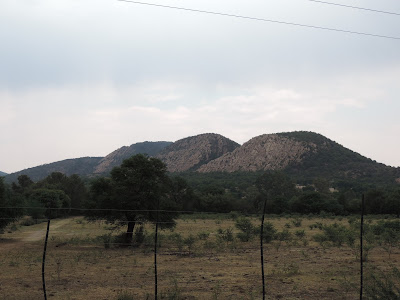Breakfast was at 7:30 so we would be ready to head off by 8:00
am to meet a guide who would tell us all about the specular happening that
created the Vredefort Dome.
The theory is that 2 billion years ago a meteorite struck
the earth near Vredefort. The meteorite
is estimated to have been 10-15 km in diameter (6-9 miles) traveling at 70,000
km/hr (44,000 mi/hr) when it hit the earth surface. This collision caused a
crater that is 300 km (180 mi) in diameter.
We spent the first hour watching a PowerPoint presentation at the
guide’s house on the collision, followed by morning tea. The rest of the day
was spent driving from location to location to see the evidence that is used to
prove the meteorite collision. We saw granite that had been shattered by the
impact and melted back together by the extreme heat. This granite was being quarried but because
it is so hard and brittle the quarrying has stopped. We went to locations where the rocks were
pushed up forming low mountain ranges, composite rocks where smaller rocks are
held together in larger rocks by the melting, similar to what happened with the
granite.

 |
| Granite that has been Shattered and Melted Together |
 |
| Our Guide with more Granite - Too Hard and Brittle to Process |
 |
| Quartzite Mountain formed by the Meteorite |
 |
| More Quartzite near the Vaal River |
 |
| Cal & Rachel with our Hosts |
 |
| Panorama of the Vaal River Valley |
In addition to seeing the meteorite evidence we also saw a
gold mine that had been in existence for 30 years in the 1890’s, but never
yielded enough gold to pay for itself.
In general, there was never enough gold found in this region at that
time to make all of the gold exploration pay for itself. It is estimated that only 123 kg (270 lb) of
gold was reclaimed during the total gold exploration that lasted no more than
50 years in the Vredefort Dome area. The
dream of wealth kept people going!
 |
| Cave where early Inhabitants lived |
 |
| Rock Formation near the Cave |
 |
| Mine Commissioner's Office |
 |
| Our Restaurant for Lunch |
We saw a cave that was used by some of the early
inhabitants. This cave is being
excavated by university students to see what can be learned as to when and who
lived here. We were taken to an area
that was inhabited by man during the iron age of civilization. All that remains are rows of rocks piled up
to form corrals for their cattle and the perimeter of their houses. In this same area we saw a lookout that was
used by the British during the Boer Wars.
It was located on the top of a ridge and provided an excellent view of
the region.
For lunch we stopped at the abandoned mining commissioner’s
office and house. This facility has had
numerous uses over the years in addition to the commissioner’s office. It has been a police station with prison,
post office and most recently a museum. It is currently
being renovated into a lodge facility complete with a restaurant, hotel,
swimming pool etc. We had our lunch on
the patio at the restaurant.
 |
| Composite Rock - Smaller Rock held together by the Heat of the Meteorite Impact |
 |
| Opening to the Gold Mine |
 |
| One of the Mine shafts |
 |
| Iron-Age Village Site - Walking in the Steps of Prehistoric Man |
 |
| Village is now a Backpackers Stop |
 |
| View from the Lookout |
 |
| Shattercone Rock - Shattered by the Meteorite Impact |
 |
| More Shattercone Rock |
 |
| The Vaal River - This Bridge is Covered when the River Floods |
 |
| Another Composite Rock - White at the top is Granite |
 |
| Early Carvings in the Rocks - An Eland |
 |
| Another Beautiful Sunset |
Our total tour of the area lasted until 4:30 pm. After dropping our guide off at his house we
stopped for some ice cream and headed back to the farm. Our final evaluation of the day was that it
was very educational and enjoyable, learning a lot about something we had no
idea existed. What happened that day when the collision occurred is
unfathomable.






























No comments:
Post a Comment